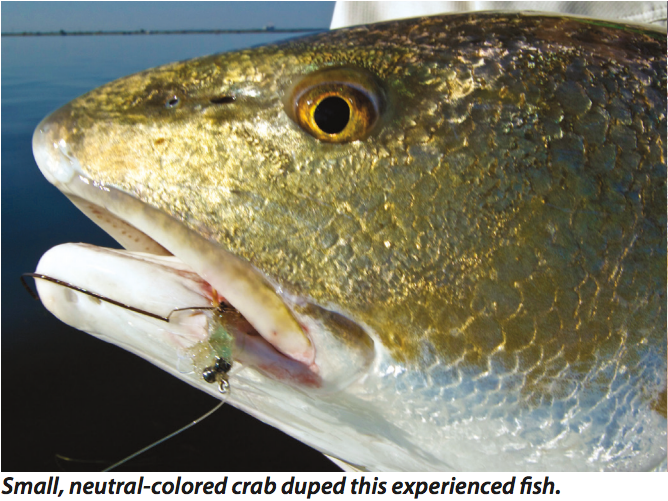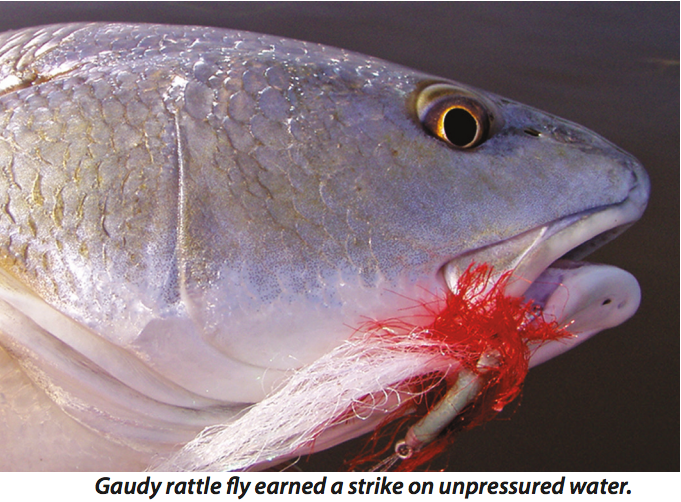November 06, 2014
By John Kumiski
Lighten up and go easy to entice hard-pressured fish.

After September 11, 2001, the east side of the no motor zone in the Banana River Lagoon was closed to all entry for four and a half years.
On the day it opened again (to badged NASA personnel and their guests only) I was there with Tom Van Horn. The first redfish I threw to took my fly four times (on four casts) before I stuck him. Talk about a willing fish! All the other fish we saw were equally aggressive. Fishing was simply off the charts.
The only people allowed to fish there were Space Center employees, but within two weeks the fish were behaving the same as fish elsewhere in the more heavily fished areas of the Indian River Lagoon.
Anyone fishing in Florida for longer than 10 years knows that the fishing is tougher now. Fish are harder to find, and harder to provoke into striking. How fish learn not to get caught may be termed “hook avoidance.”
Here's another example. When I began fly fishing for big tarpon back in the 1980s, 100-pound-test monofilament was the standard bite tippet. Flies, usually tied on 4/0 and 5/0 hooks, often measured four or five inches long.
Now tarpon bite tippets are often too heavy to get the bite if 50-pound fluorocarbon is used. Tarpon toads are tied on hooks as small as size 2. The angler has to make a tough choice—either use toolight terminal tackle, or don't get bit.
So, what do we do about it?The standard fly outfit for Florida's saltwater flats fishers has been the 8-weight. The first 30 feet of an 8-weight line weighs 210 grains. The first 30 feet of a six-weight line only weighs 160 grains. The splash a 6-weight fly line makes is significantly less than that an 8-weight line makes. Downsize your gear to get more bites from spooky flats fish.

While fishing for redfish in Texas and Louisiana, my guides routinely used 6- or 7-foot-long leaders. They were astonished at my 10- and 12-foot ones. In the Indian River Lagoon on a calm day, a 12-foot leader is often not long enough. You can tell from the wake that rockets away when your fly line hits the water.
Spooky fish demand more leader. Keep lengthening it until you start to see the results you want.
A lighter rod and a longer leader demand more casting skill. If you want to catch more fish, start practicing.
The last bit of tackle advice concerns the fly. Spooky fish don't like flies that “plop” when they hit the water. On weighted flies, cushion the lead eyes to quiet their entry.
Years ago big, brightly colored flies worked well for the redfish in the Indian River Lagoon. Now, smaller, darker colored flies work better. This is a generalization, but it's solid advice.
Try to have some flies unique to you. Fish that see fishermen every day could probably tell you (if they could talk) how to tie a Clouser Minnow. It's a good fly, but something they haven't seen might work better.
Longtime flats angler Bob Stearns had this to say about stalking flats fish:
“Stop the boat at the edge of the flat and use the wind, the current, and a pushpole to get up there and work it. I'm big on boats that don't have any hull slap. The fish have become very sensitized to any noise that isn't a natural part of their environment.
“You often have to lead the fish a little further. Cast way out in front and hope the fish see what you're offering. Nowadays you throw even a light fly on top of the fish and you get a muddy trail heading off of the flat.
“You have to watch the fish's behavior and body language. It doesn't make any sense to throw a fly at a fish that's swimming away. A cast to a nervous fish will most likely spook it off the flats.
“You need to find undisturbed, happy fish. If it ain't happy, don't waste your time casting to it.” - FS
First Published Florida Sportsman July 2013

